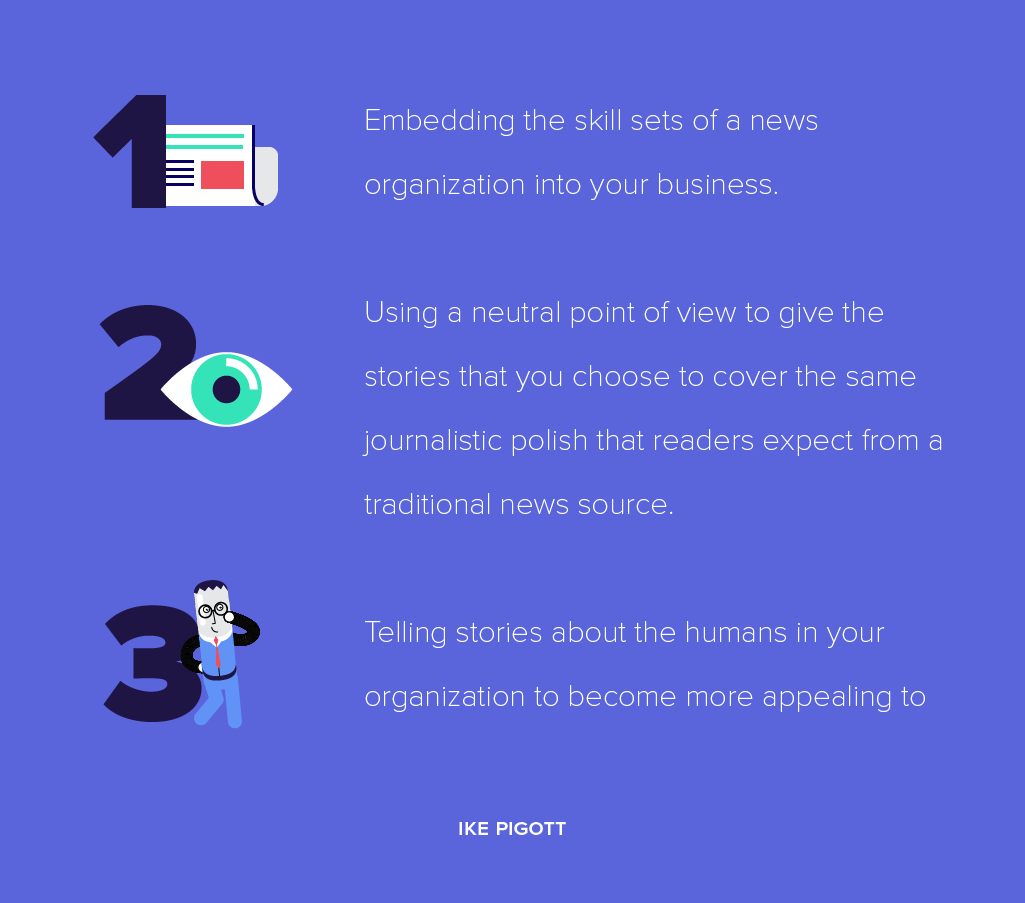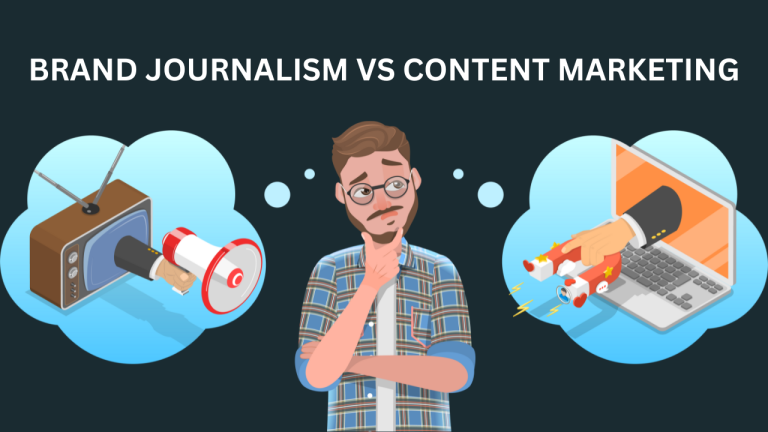Discover the differences between brand journalism vs content marketing, and find out which strategy best fits your business goals and audience.
Although it may overlap with brand journalism, content marketing plays a different, supporting role in the strategy behind these pieces of media. Brand Journalism: Uses different stories that brand its narrative, defining the voice of a company. It usually consists of historical content, articles, and media, i.e. anything that builds a strong brand image.
Whereas content marketing is primarily interested in providing useful and relevant information to a target market, they focus on the other side of that coin: getting it, damnit The greater idea behind this method is to bring a customer into some sort of profitable action and then establish a long-term relationship. While both deliver an engaging experience, each focuses on a different area and way of doing so. Knowing these differences allows businesses to combine elements of each strategy into one larger plan — and use the best of both for optimal results.

Credit: sarahskerik.me
Introduction To Brand Journalism
Simply stated, brand journalism is a digital version of how businesses can tell their stories today. Combining Traditional Journalism with Strategic Marketing It increases the trust among people and stages a great platform for brands to engage with their audiences.
Definition And Purpose
Brand journalism is about telling engaging stories of a brand. Stories that our audience can relate to. It is to learn, engage and retain.
Brand journalism delivers value, rather than just advertising. Provides you tips & tricks That can help the viewers feel more engaged and in the know.
Historical Background
Remember that brand journalism has its roots in earlier forms of corporate communications. That was one of the earliest forms of content marketing.
Brand journalism sped up in the digital age. Social media and blogging has made stories easier to share. These days it is used by many brands inorder to talk to their audience.
From Newsletters to Multimedia: The Evolution of Brand Journalism They are the usual mix of video, podcast and interactive article. What stays the same: Coupons with stories are still interesting aims

Credit: www.business2community.com
Content Marketing Introduction
For businesses, Content marketing is a hand of cards. This allows them to connect better with the audience. In the first part, we are discussing content marketing which starts from scratch.
Definition And Goals
It is a type of content marketing where you make and share useful content. You want to be able to attract that audience — and keep them coming back. Content marketing is used by businesses to drive profitable customer actions. That content can come in different mediums like blog posts, videos and social media posts.
Content marketing is not advertising, it provides value. It seeks to create trust and loyalty on the part of the client. Businesses can position themselves as industry leaders by delivering informational content.
Evolution And Growth
There has been a lot of evolution in content marketing over the years. At first, it was limited to simple blogs and articles. Today, it includes a host of different media types. Its growth has been attributed to social media platforms. Help businesses to get Unlimited Reach across the Audience.
Digital tools have also contributed to the growth in content marketing. Businesses employ tools like thus using analytics and seo for content optimization. It provides you with more visibility as well as engagement. Content marketing appears to have a new future with the advent of some new technologies.
Core Differences
Marketers are often puzzled by the terms Brand Journalism vs Content Marketing. They both want to engage and connect with people. However, at their heart they are quite different. In this post we take a closer look at the key differences between them.
Audience Focus
The audience for Brand Journalism is the whole wide world. It is designed to be an information resource. Like traditional news, the content often looks. This should work to gain trust and credibility.
Content Marketing — While still related, Content Marketing is a little more specific. It is trying to bring the right customers in. Purpose: Drive sales and convert It has to do with identifying the problems and providing solutions.
Content Creation Approach
In short, the Brand Journalism is a magazine that keeps things tight to journalistic standards. It focuses on narrative and not fake news. To deliver conferencing experience in a story telling way. Also notice that these stories almost always indirectly feature the brand.
Content Marketing is more of a strategic approach to market. This means to generate content with a good CTA. It is an essential element that helps the audience navigate through the sales funnel. Whether that is blog posts, videos, social or otherwise.
Aspect Brand Journalism Content Marketing Audience Focus Broad, informational Narrow, sales-driven Strategy Storytelling, factual Strategic, sales-focused Goal Build trust and credibility Drive conversions and sales
Brand Journalism Strategies
Brand journalism is a powerful tool for companies. It tells compelling stories about their brand. Brands use journalism techniques to engage audiences. These strategies help build trust and loyalty. Below, we explore two critical techniques: storytelling and real-life examples.
Storytelling Techniques
Storytelling is at the heart of brand journalism. It captures the audience’s attention. Use these techniques to craft engaging stories:
- Authenticity: Share real experiences and genuine emotions.
- Character-driven: Focus on relatable characters.
- Conflict: Introduce challenges and resolutions.
- Visual Elements: Use images and videos to enhance the story.
- Emotion: Evoke emotions to connect with your audience.
Real-life Examples
Real-life examples make brand journalism relatable. They show how a brand impacts lives. Consider these successful examples:
| Brand | Example | Impact |
|---|---|---|
| Coca-Cola | “Share a Coke” campaign | Increased customer engagement |
| Airbnb | Host Stories | Built trust and community |
| GoPro | User-generated content | Showcased product capabilities |
These examples highlight the power of brand journalism. They show how storytelling and real-life examples can engage audiences effectively.
Content Marketing Strategies
Content marketing strategies are essential for engaging and converting your audience. These strategies include various tactics that help in reaching your target market effectively.
Seo And Keywords
SEO and keywords play a vital role in content marketing. SEO helps your content rank higher on search engines. This increases visibility and traffic. To achieve this, you must use relevant keywords. These keywords should align with what your audience is searching for.
Using tools like Google Keyword Planner can help find these keywords. Ensure to place these keywords in your:
- Headings
- Meta descriptions
- Content body
- Image alt texts
By doing this, your content becomes more discoverable.
Content Distribution Channels
Choosing the right content distribution channels is crucial. These channels determine how your content reaches your audience. There are several types of channels to consider.
Here is a table to illustrate different content distribution channels:
| Type | Examples |
|---|---|
| Owned | Website, Blog, Email Newsletter |
| Earned | Social Shares, Guest Posts, Mentions |
| Paid | Google Ads, Social Media Ads, Sponsored Content |
Owned channels are platforms you control. Use them to consistently share your content. Earned channels are where others share your content. This helps in building trust and authority. Paid channels can amplify your reach quickly. They require investment but offer targeted reach.
Utilize a mix of these channels for an effective content distribution strategy.
Measurement And Metrics
Understanding measurement and metrics is crucial in Brand Journalism and Content Marketing. Both approaches aim to engage the audience, but their success metrics differ.
Brand Journalism Metrics
Brand Journalism focuses on storytelling and building a brand’s narrative. Here are key metrics to consider:
- Engagement Rate: Measures likes, shares, and comments on articles.
- Brand Sentiment: Assesses how audiences feel about the brand.
- Media Reach: Tracks the number of publications featuring brand stories.
- Website Traffic: Monitors visitors to the brand’s story pages.
These metrics help understand the audience’s emotional connection with the brand.
Content Marketing Kpis
Content Marketing aims to drive conversions and generate leads. Here are essential KPIs:
| Metric | Description |
|---|---|
| Conversion Rate | Percentage of visitors completing a desired action. |
| Lead Generation | Number of new leads captured through content. |
| Website Traffic | Number of visitors to landing pages. |
| SEO Performance | Rankings and organic search traffic. |
These KPIs provide insights into the effectiveness of content strategies and overall business impact.
Challenges And Pitfalls
Understanding the challenges and pitfalls of both Brand Journalism and Content Marketing is crucial. Each strategy has unique issues that can hinder its effectiveness. Knowing these can help in crafting better strategies.
Common Issues In Brand Journalism
Brand Journalism often faces several common issues that can limit its success:
- Bias and Credibility: Readers may distrust branded content. They might see it as biased.
- High Costs: Quality journalism requires skilled writers. This can be expensive.
- Time-Consuming: Creating in-depth stories takes time. This can delay publication schedules.
- Balancing Act: Combining brand promotion with valuable content is hard. It can be tricky to find the right balance.
Hurdles In Content Marketing
Content Marketing also has its own hurdles that can impact its success:
- Content Saturation: The internet is flooded with content. Standing out is challenging.
- SEO Challenges: Keeping up with search engine algorithms is tough. This affects content visibility.
- Quality vs. Quantity: Producing high-quality content consistently is difficult. Many opt for quantity over quality.
- Measuring ROI: Tracking the return on investment can be complex. It’s hard to measure the effectiveness.
Both Brand Journalism and Content Marketing have their pros and cons. Understanding the challenges and pitfalls helps in crafting effective strategies.

Credit: prowly.com
Future Trends
Brand Journalism and Content Marketing are evolving rapidly. The future holds exciting trends. These trends will shape how brands connect with audiences. Let’s explore them in detail.
Innovations In Brand Journalism
Brand Journalism is blending storytelling with facts. This trend is growing stronger. Here are some innovations to watch:
- Data-Driven Stories: Brands will use data to create compelling stories.
- Interactive Content: Videos and infographics will become more interactive.
- AI-Generated Content: Artificial Intelligence will help create personalized content.
- Immersive Experiences: Virtual Reality and Augmented Reality will enhance storytelling.
These innovations will make brand journalism more engaging. They will also increase audience trust and loyalty.
Emerging Content Marketing Trends
Content Marketing is also evolving. New trends are emerging that will redefine strategies. Here are some key trends:
- Voice Search Optimization: Content will be optimized for voice search.
- Video Content: Short, engaging videos will dominate.
- Personalization: Tailored content for individual users will be crucial.
- Content Diversification: Brands will use various formats like podcasts and webinars.
- Social Media Stories: Stories on social media will continue to grow in popularity.
These trends will shape the future of content marketing. Brands need to adapt to stay relevant.
In summary, the future of Brand Journalism and Content Marketing is bright. Innovations and emerging trends will lead the way. Brands that embrace these changes will thrive.
Brand journalism vs content marketing examples
Brand journalism and content marketing may seem similar, but they have distinct goals. Brand journalism focuses on storytelling and providing news-like content about a brand. It aims to build a narrative around the brand’s values, culture, and industry. For example, Coca-Cola’s “Journey” website shares stories about sustainability and innovation, giving insight into the brand’s identity.
Content marketing, on the other hand, is about creating valuable content to attract and convert customers. A good example is HubSpot’s blog, which offers tips on digital marketing. It educates readers and subtly promotes its products as solutions to their challenges.
Frequently Asked Questions
What Is Brand Journalism?
Brand journalism focuses on storytelling to build a brand’s identity. It creates engaging narratives that resonate with the audience. This approach fosters brand loyalty and trust.
How Does Content Marketing Differ?
Content marketing aims to attract and retain customers. It uses valuable content to drive profitable actions. The goal is to educate and engage potential customers.
Which Is Better For Brand Awareness?
Both are effective for brand awareness. Brand journalism builds emotional connections, while content marketing provides value. Combining both can maximize results.
Can Brand Journalism Boost Seo?
Yes, brand journalism can improve SEO. High-quality, engaging stories attract more visitors. This increases site traffic and search engine rankings.
Conclusion
Choosing between Brand Journalism vs Content Marketing depends on your goals. Both strategies offer unique benefits. Brand journalism builds trust with storytelling. Content marketing drives engagement and conversions. Understanding your audience’s needs is key. Combining both can create a powerful strategy.
Focus on delivering valuable content to achieve success.
<script type="application/ld+json">
{
"@context": "https://schema.org",
"@type": "Article",
"mainEntityOfPage": {
"@type": "WebPage",
"@id": "https://digitalearninglab.com/brand-journalism-vs-content-marketing/"
},
"headline": "Brand Journalism Vs Content Marketing: Unveiling the Differences",
"description": "Brand Journalism Vs Content Marketing: Unveiling the Differences",
"image": "https://digitalearninglab.com/wp-content/uploads/2024/10/Orange-Tutorials-YouTube-Thumbnail-1024x576.png",
"author": {
"@type": "",
"name": ""
},
"publisher": {
"@type": "Organization",
"name": "",
"logo": {
"@type": "ImageObject",
"url": ""
}
},
"datePublished": ""
}
</script>

